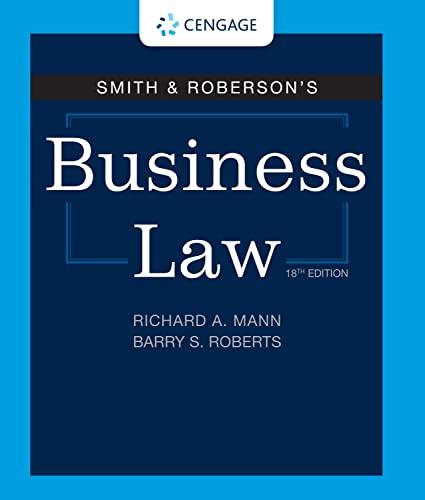Question
1. _______________ held that a preliminary hearing is a critical stage requiring court-appointed counsel for indigent defendants. Group of answer choices Coleman v. Alabama Stack
1. _______________ held that a preliminary hearing is a critical stage requiring court-appointed counsel for indigent defendants.
Group of answer choices
Coleman v. Alabama
Stack v. Boyle
Gerstein v. Pugh
County of Riverside v. McLaughlin
2.In _____________ the U.S. Supreme Court established a 4-prong balancing test for determining whether a defendant's right to a speedy trial was violated.
Group of answer choices
Stack v. Boyle
Barker v. Wingo
Coleman v. Alabama
Smith v. Cain
3. The U.S. Supreme Court held that the right to indictment by a grand jury does not apply to state criminal prosecutions in:
Hurtado v. California
County of Riverside v. McLaughlin
Smith v. Cain
Coleman v. Alabama
4.The right to indictment by a grand jury does not apply in state criminal prosecutions.
True
False
5.The exclusionary rule was first announced in:
Weeks v. United States
Mapp v. Ohio
Boyd v. United States
Terry v. Ohio
6.In __________ the U.S. Supreme Court applied the exclusionary rule in federal criminal trials based on violations of the 4th Amendment.
Group of answer choices
Mapp v. Ohio
Terry v. Ohio
Boyd v. United States
Weeks v. United States
7.In __________ the U.S. Supreme Court incorporated the exclusionary rule, applying it to state criminal trials.
Mapp v. Ohio
Weeks v. United States
Terry v. Ohio
Coleman v. Alabama
8.In _________ the U.S. Supreme Court held that there is an exception to the warrant requirement for searches incident to a lawful arrest - explaining that a suspect's "wingspan" can be searched.
Group of answer choices
Katz v. United States
Mapp v. Ohio
Weeks v. United States
Chimel v. California
9._____________ evidence is inadmissible because of its connection to unlawfully obtained evidence - it is "fruit of the poisonous tree."
Group of answer choices
Derivative
Direct
Primary
Secondary
10.In ______________ the U.S. Supreme Court held that officers need not Mirandize suspects if there is a threat to public safety.
Group of answer choices
Minnick v. Mississippi
Wong Sun v. United States
Mapp v. Ohio
New York v. Quarles
11.In federal cases a ____ member jury is utilized, and their decisions must be unanimous.
14
6
12
18
12._______ evidence could include a letter, contract, or document.
real
testimonial
demonstrative
documentary
13.n opening statements, the attorneys may:
only show a power point with terms and definitions.
argue why their side is correct and why the jurors should believe them.
only explain what the evidence will show.
explain everything about the case to the jury.
14.When a punishment attempts to identify and address the underlying reasons for criminal conduct it is:
Deterrence
Rehabilitation
Incapacitation
Retribution
15.____________ re-established the death penalty as a constitutional form of punishment after the Supreme Court's holding in Furman v. Georgia had briefly suspended its use it the United States.
United States v. Booker
Payne v. Tennessee
Gregg v. Georgia
United States v. Watts
Step by Step Solution
There are 3 Steps involved in it
Step: 1

Get Instant Access to Expert-Tailored Solutions
See step-by-step solutions with expert insights and AI powered tools for academic success
Step: 2

Step: 3

Ace Your Homework with AI
Get the answers you need in no time with our AI-driven, step-by-step assistance
Get Started


